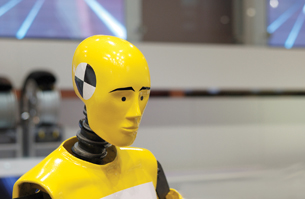Module 1
1. Module 1
1.1. Big Picture
Module 1—Momentum and Impulse
 Big Picture
Big Picture
According to the August 2007 Canadian Vehicle Survey conducted by Statistics Canada, there were an estimated 2 533 947 vehicles in Alberta. This number includes an estimated 113 729 vehicles that had masses in the range of 4.5-tonne delivery trucks to 14.9-tonne tractor semitrailers.

© Manfred Steinbach/shutterstock/2939101
Considering the mass of all of the vehicles, and the velocity at which those vehicles travel, there is plenty of momentum on Alberta’s roads. Given the large number of vehicles, there is little doubt that accidents involving large forces and changes in momentum will be experienced by the human occupants of colliding vehicles.
Consider the crash test dummy. Smashed, crushed, bent, and battered, the dummy serves as a simulated human being that does not experience the real pain and cost of a vehicle collision.

© trialart-info/shutterstock
Crash test dummies are the lone occupants of a vehicle travelling at high velocity, with a large amount of momentum, only to change their momentum dramatically when the vehicle makes contact with another vehicle or barrier. In the collision, forces act to change the momentum of the vehicle and occupant, testing the effectiveness of safety systems, such as air bags and crumple zones, in the vehicle.
But before a vehicle races down the track to certain destruction during collision testing, investigators need to understand how the concepts of momentum and impulse can be applied to understand the function and design requirements of vehicle safety devices.
As you are working in Module 1, keep the following questions in mind:
-
What do we really mean when we say “speed kills”?
-
How is it possible to reduce injury and death when a vehicle occupant experiences a large change in momentum during a collision?
In this lesson you will be working with vectors as you did in Physics 20. During the lesson, before you have any vector questions, there is an opportunity for you to review vector addition.
 Module Assessment
Module Assessment
Each lesson has a teacher-marked assignment based on work completed in the lesson. In addition, you will be graded on your contributions to the Discuss section of each lesson.
You will also be asked to complete Self-Check or Try This questions, which you should place in your Physics 30 course folder. These are not formally assessed but are a valuable way to practise the concepts and skills of the lesson. These activities can provide you with reflective feedback on your understanding of the lesson work.
You will be marked for your lesson work on the following items:
-
Module 1: Lesson 1 Assignment
-
Module 1: Lesson 2 Assignment
-
Module 1 Project
In the context of each lesson, you will explain why “speed kills” and how modern vehicle safety devices work to reduce the force experienced by vehicle occupants involved in a collision.
After you have completed both lessons, you will do a module assessment that consists of three questions similar to diploma exam written response questions. These questions will require you to apply your knowledge and skills to a practical application of momentum in a crash test scenario. As this is your first module assessment, make sure that you read the marking rubrics and the self-evaluation questions to be sure that you have answered the questions completely and understand what will be evaluated.
If at any point you are having any concerns or difficulties, contact your teacher for specific feedback.